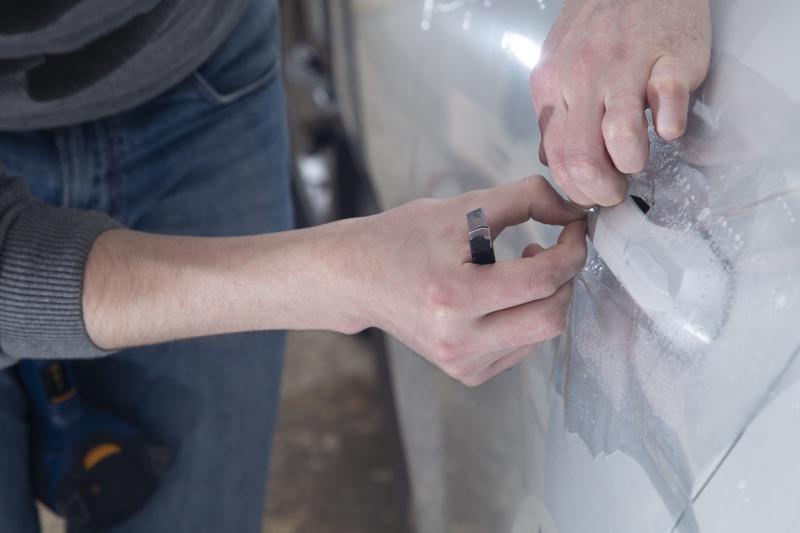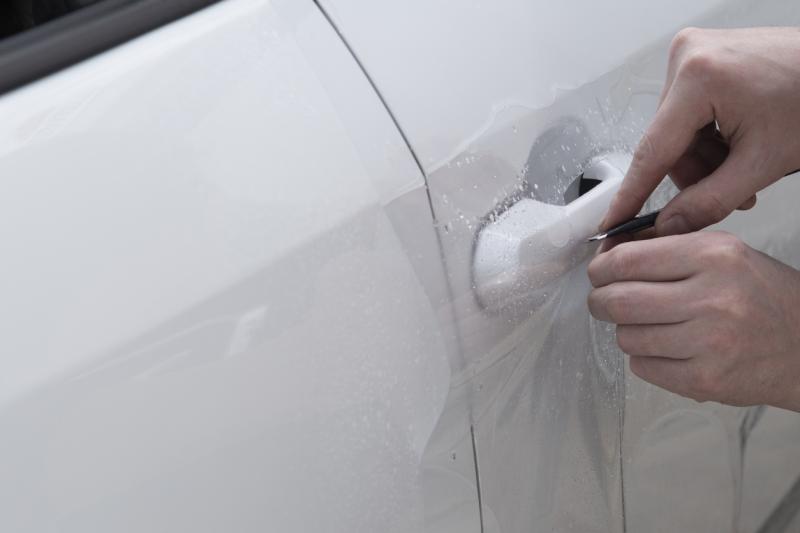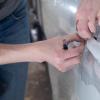Does Paint Protection Film Work?

Paint protection film is one of the most popular methods of vehicle protection today. But is it worthwhile? Let's look at what this film does and how it works to make your own decision.
What is paint protection film (PPF)?
PPF serves a very valuable purpose today. But in fact, it started out during the Vietnam War era to solve a different military problem. The U.S. Department of Defense noted their helicopter rotor blades routinely suffered damage caused by trees, shrapnel and other debris, necessitating replacement or repair. This costly problem needed a quickly applied solution to keep the choppers up and running.
Researchers at 3M created a protective film layer that was light enough not to inhibit the proper operation of the rotor blades. Yet, their newly created film was also highly durable. The original name for PPF was "helicopter tape."
This helicopter tape evolved to become the film that vehicle owners love today. The original was a type of urethane, and today it is similar, a transparent or tinted thermoplastic urethane film with gloss or matte finish. There are multiple grades of this film available on the market, along with varying thicknesses. Although there are some DIY kits available, the best quality film is applied by trained professionals.

PPF Benefits
There are multiple benefits of today's PPF. These benefits include:
- Acidic corrosion and contaminant resistant, preventing paint damage from acid rain, bug splatters and bird droppings
- Protective of paint from mineral deposits and both hard and soft water spots
- Blocking UV light rays from the sun to reduce factory paint oxidation
- Blocking small debris like rocks, gravel and tree branches from causing paint damage
- Able to "heal" itself when the PPF is scratched or struck
- Long-lasting, with the resiliency of 10 years or more
Does paint protection urethane work?
A short answer to the question of whether PPF works is a resounding "yes." Over recent years, the PPF industry has continued to evolve. No longer do these urethane films quickly yellow or become dull while on the vehicle. With quality products and professional installation, you gain an invisible layer of protection that enhances the quality and appearance of your paint by helping it retain its vibrancy.
The coating also heals light swirls and scratches through molecular fusion to provide a glossy and shiny finish. This coating absorbs debris impact to keep chips and scratches from occurring in the first place.
It is necessary to clarify that PPF is hardly bulletproof. It is possible to scratch or puncture the film with effort or intensity. But the film works well in protecting your paint as your vehicle's first line of defense against such markings. The odds of damaging your paint with the film in place is much lower than without it.
If you routinely subject your vehicle to extraordinary circumstances that can lead to damage, such as regularly driving on gravel roads or engaging in racing, there are thicker films available. These thicker PPFs suit high-impact areas of your vehicle to provide even greater protection.
Is it worth the cost?
Whether or not the film suits your own needs and proves worthwhile is an individual matter. Some people place great value in protecting their cars, while others are okay with letting the paint age or take on damage. The ideal person for investment in PPF is a vehicle owner who plans to keep their car as long as they can. Or, at least they want to keep it looking shiny and new for longer.
It can help to consider why you have interest in protective film, before making the investment. To help in this decision-making, ask yourself some simple questions:
- What is the monetary value of my car?
- Will paint damage really devalue my vehicle?
- Do I want the car to look as perfect as possible for as long as it can?
- Am I bothered by swirls or scratches on the paint?
- Do I do a lot of highway driving?
- To me, what is the value of maintaining my car's appearance?
Through the above questions and the answers you provide, you should be able to decide if an investment in this urethane film is the right choice. Once you decide to proceed, start looking for a professionally trained installer. It is important to work with someone who is skilled in this service and provides a warranty for their work.
To find such a qualified person, look for one who has relationships with leading PPF manufacturers. You should also seek one who has been working in your local market for a lengthy period of time. It is best to work with a proper facility, one designed to shelter the vehicle from the elements during and after installation. The individual or shop should also invest heavily in the products and equipment they use.
With the popularity of social media and other image sharing by smartphones, there is no reason why your prospective installer should not have photos of finished client work. Review these past jobs as examples of how your outcome can look. The installer should also have pride in their results.
Ask the individual installer what makes their work worth paying for. They should talk proudly about the details of their process and associated results. The professional who is willing to go above and beyond to discuss their quality and workmanship should stand out above the rest. But of course, their claims must be backed by customer reviews, quality facilities and photos.
When you find an experienced installer who really enjoys their work and puts in the extra effort to deliver exceptional quality, you have likely located the right choice. Ask them about the brand of paint protection film they will use, manufacturer's warranty, whether their work is guaranteed and fees associated with the process. After all of this time and effort, you should get the results you want. Your vehicle's coating will last years to come and you can have pride in how it looks.
More to Read:
Previous Posts:



